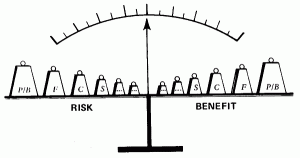 About a week ago, a reader sent me a message, asking my thoughts about sedating horses in order to make riding them easier. I love it when readers give me good ideas for articles – I hope you’ll feel free to message me with thoughts as to what you think might be interesting reading material. With that introduction, for this article, I’d like to address a questions about something that I think is commonly done, but not commonly discussed. That is, “Should you sedate your horse to ride him?”
About a week ago, a reader sent me a message, asking my thoughts about sedating horses in order to make riding them easier. I love it when readers give me good ideas for articles – I hope you’ll feel free to message me with thoughts as to what you think might be interesting reading material. With that introduction, for this article, I’d like to address a questions about something that I think is commonly done, but not commonly discussed. That is, “Should you sedate your horse to ride him?”
 Let’s start off our discussion in Nirvana. In a perfect world, this isn’t a question you have to bring up. All horses in Nirvana are calm and happy, all riders are accomplished and gentle, and all horse:rider pairs move effortlessly and easily through gates, around and over fences, around poles, stepping high, moving slowly: whatever is required. Presumably, at the horse shows in Nivana, everyone ties for first place. In Nirvana, the idea that you might have to sedate a horse to keep him calm in order to do any of the curious things that we ask from horses wouldn’t ever come up. It’s Nirvana, right?
Let’s start off our discussion in Nirvana. In a perfect world, this isn’t a question you have to bring up. All horses in Nirvana are calm and happy, all riders are accomplished and gentle, and all horse:rider pairs move effortlessly and easily through gates, around and over fences, around poles, stepping high, moving slowly: whatever is required. Presumably, at the horse shows in Nivana, everyone ties for first place. In Nirvana, the idea that you might have to sedate a horse to keep him calm in order to do any of the curious things that we ask from horses wouldn’t ever come up. It’s Nirvana, right?
 Unfortunately, Nirvana doesn’t exist. Not every horse is perfect and not every rider is talented, in shape, fearless, or accomplished. In this imperfect world, sometimes people look for a little help. Sometimes it’s more than help; sometimes they look for a little advantage. Help is likely not so bad; advantage is often a euphemism for “cheating.” Every situation may be a little different. Let’s look at some of them.
Unfortunately, Nirvana doesn’t exist. Not every horse is perfect and not every rider is talented, in shape, fearless, or accomplished. In this imperfect world, sometimes people look for a little help. Sometimes it’s more than help; sometimes they look for a little advantage. Help is likely not so bad; advantage is often a euphemism for “cheating.” Every situation may be a little different. Let’s look at some of them.
The horse first (the horse should always come first). If someone thinks that a horse needs to be sedated before riding, it’s usually because either the horse is a bit excitable or the rider is less accomplished than he or she wants to be. In these cases, sedation of the horse is usually done for the safety of the and in order to try to help get the horse to settle down and do his job. Frankly, I think that’s a good thing, at least in concept. Nobody wants anybody to get hurt. In general, a mildly sedated horse is probably a bit safer than a wildly active and uncontrollable horse. In my view, if something can be done to a horse and there’s no harm to the horse or rider, then I’m inclined to think favorably of the practice.
 BUT WHAT ABOUT SIDE EFFECTS TO THE HORSE? I’d be completely against the idea of sedating a horse for riding if sedation was a demonstrable danger to the horse or rider. Fortunately, there seems to be very little harm, or at least, there is a notable lack of reports of harm from sedating a horse prior to riding it. Even so, while there’s very little chance of direct harm coming from sedating a horse prior to riding it, the practice is not completely risk free. The risks can be summed up as:
BUT WHAT ABOUT SIDE EFFECTS TO THE HORSE? I’d be completely against the idea of sedating a horse for riding if sedation was a demonstrable danger to the horse or rider. Fortunately, there seems to be very little harm, or at least, there is a notable lack of reports of harm from sedating a horse prior to riding it. Even so, while there’s very little chance of direct harm coming from sedating a horse prior to riding it, the practice is not completely risk free. The risks can be summed up as:
- Some sort of side effect from the medication, or
- Harm to the horse and/or rider if the horse is uncoordinated from the sedative and while being trips or falls. Of course, there’s also a risk of harm if a crazy horse is completely coordinated while someone is attempting to rider it, but that’s why such horses may be sedated in the first place, right?
 As for #1, There really is not much chance of direct harm to the horse from most sedatives. Acepromazine, which is an old human antipsychotic drug that has been used in horses for a long time, is one commonly used medication to sedate horses prior to riding them. While it’s not a super potent sedative, it is long-lasting, and it probably causes less incoordination than other sedatives. That’s why it’s likely the most commonly used medication for sedating horses prior to riding.
As for #1, There really is not much chance of direct harm to the horse from most sedatives. Acepromazine, which is an old human antipsychotic drug that has been used in horses for a long time, is one commonly used medication to sedate horses prior to riding them. While it’s not a super potent sedative, it is long-lasting, and it probably causes less incoordination than other sedatives. That’s why it’s likely the most commonly used medication for sedating horses prior to riding.
Acepromazine, however, is not completely risk free. It has a very, very occasional (as in almost never) side effect in male horses, more commonly stallions, but very occasionally in geldings, too. That side effect is a partial paralysis of the penis, known in medical terms as paraphimosis (I have to throw words like that out there from time-to-time; I paid a lot of money to learn them). This side effect appears to be somewhat dependent on the dose – the more you give, the more likely there are going to be problems. Still, even this problem can be successfully treated in many horses. And the risk has been estimated to be less than 1 case per 10,000 horses. So, while it’s a potential side effect, it’s not a common side effect.

As for #2, there just aren’t a lot of reports of injury to horses or riders as a result of sedating horses prior to riding. That’s not to say it’s impossible, just that if it happens a lot, it’s not being mentioned.
 I tend to look at things in terms of risks and benefits. There’s no situation that is completely risk free. If you have a gelding that’s a bit on the wild side, there’s a known risk of him acting up and getting you off his back. If you give him some acepromazine, maybe there’s a slight risk of a complication of penile paralysis. There’s risk either way. To me, it’s entirely reasonable to consider giving a bit of medication in order to decrease the risk of injury.
I tend to look at things in terms of risks and benefits. There’s no situation that is completely risk free. If you have a gelding that’s a bit on the wild side, there’s a known risk of him acting up and getting you off his back. If you give him some acepromazine, maybe there’s a slight risk of a complication of penile paralysis. There’s risk either way. To me, it’s entirely reasonable to consider giving a bit of medication in order to decrease the risk of injury.

Woman holding a glass of red wine sitting in front of an open fire
Of course, there are some people who will assert that it’s always bad to have to give drugs to a horse if you’re going to ride them. I understand that opinion and I respect it. For those folks, there are other options. You can see if training helps. You can exercise the heck out of the horse before you get on it. This, however, increases the risk of injury – nothing is risk free. You can get rid of the horse and get a new horse, but that’s hard if you’re attached to the horse. However, the way I look at it, If a horse can have a caring, loving home, albeit one that requires a little medication to relax, that’s not really a whole lot different than having a glass of wine after a long, hard day (oh, right, some would say that’s wrong, too)?
There are other medications used to sedate horses, of course, but these tend to be used more for restraint. These medications, however, tend to be shorter lived or have more risk of incoordination. Longer lasting medications to sedate horses may have more side effects.
 All of this said, when it comes to horses in competitions, there are strict rules against sedating horses. In competitions, people are looking to play on level playing fields. Here, I think you should follow the rules. There are all sorts of fines and penalties if you don’t follow the rules, and who wants that? If one doesn’t like the rules, then work to change them: don’t cheat.
All of this said, when it comes to horses in competitions, there are strict rules against sedating horses. In competitions, people are looking to play on level playing fields. Here, I think you should follow the rules. There are all sorts of fines and penalties if you don’t follow the rules, and who wants that? If one doesn’t like the rules, then work to change them: don’t cheat.
I think that there is lots of room for a variety of opinions in this discussion. I think it’s fine to be of the opinion that no horse should ever be sedated to be ridden, for example. But I do think that there’s room for making adjustments for individual circumstances, as well.
If you are wondering if your horse might benefit from a bit of tranquilization prior to being ridden, please check with your veterinarian first. Check with your trainer, if you have a trainer, to get their advice and experience. None of this is cut-and-dried. Still, while this is certainly decision that should be made fully informed, and considering the risks, at least sedating a horse prior to riding him doesn’t seem to carry a big risk of harm.
Life: it’s complicated.







